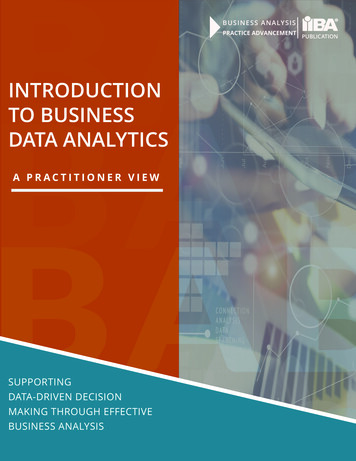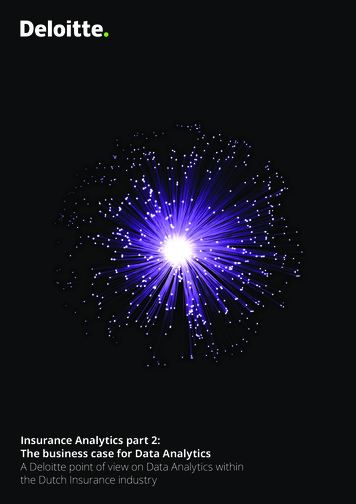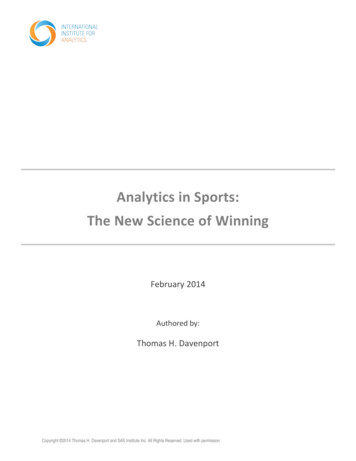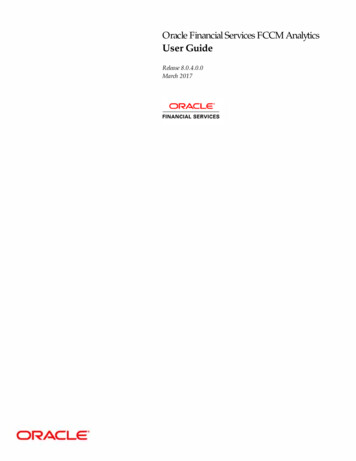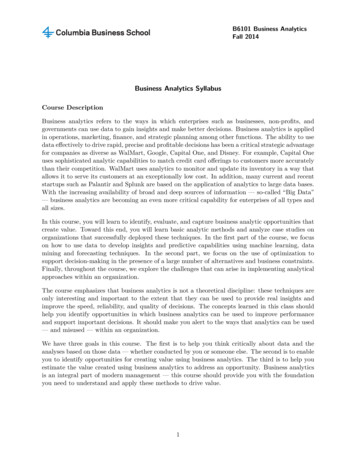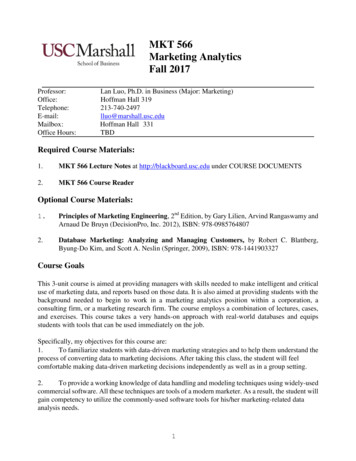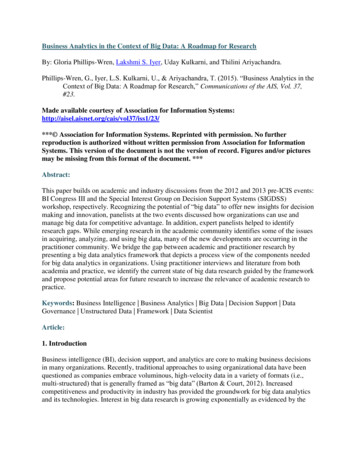
Transcription
Business Analytics in the Context of Big Data: A Roadmap for ResearchBy: Gloria Phillips-Wren, Lakshmi S. Iyer, Uday Kulkarni, and Thilini Ariyachandra.Phillips-Wren, G., Iyer, L.S. Kulkarni, U., & Ariyachandra, T. (2015). “Business Analytics in theContext of Big Data: A Roadmap for Research,” Communications of the AIS, Vol. 37,#23.Made available courtesy of Association for Information /*** Association for Information Systems. Reprinted with permission. No furtherreproduction is authorized without written permission from Association for InformationSystems. This version of the document is not the version of record. Figures and/or picturesmay be missing from this format of the document. ***Abstract:This paper builds on academic and industry discussions from the 2012 and 2013 pre-ICIS events:BI Congress III and the Special Interest Group on Decision Support Systems (SIGDSS)workshop, respectively. Recognizing the potential of “big data” to offer new insights for decisionmaking and innovation, panelists at the two events discussed how organizations can use andmanage big data for competitive advantage. In addition, expert panelists helped to identifyresearch gaps. While emerging research in the academic community identifies some of the issuesin acquiring, analyzing, and using big data, many of the new developments are occurring in thepractitioner community. We bridge the gap between academic and practitioner research bypresenting a big data analytics framework that depicts a process view of the components neededfor big data analytics in organizations. Using practitioner interviews and literature from bothacademia and practice, we identify the current state of big data research guided by the frameworkand propose potential areas for future research to increase the relevance of academic research topractice.Keywords: Business Intelligence Business Analytics Big Data Decision Support DataGovernance Unstructured Data Framework Data ScientistArticle:1. IntroductionBusiness intelligence (BI), decision support, and analytics are core to making business decisionsin many organizations. Recently, traditional approaches to using organizational data have beenquestioned as companies embrace voluminous, high-velocity data in a variety of formats (i.e.,multi-structured) that is generally framed as “big data” (Barton & Court, 2012). Increasedcompetitiveness and productivity in industry has provided the groundwork for big data analyticsand its technologies. Interest in big data research is growing exponentially as evidenced by the
increase in the number of papers, tracks, and mini- tracks focused on analytics and big data inleading IS conferences.The Association for Information Systems (AIS) Special Interest Group in Decision Support andAnalytics (SIGDSA, formerly SIGDSS) and the Teradata University Network have organizedpre-International Conference on Information Systems (ICIS) events since 2009 on data analytics(e.g., BI Congresses I, II, III (2009, 2010, 2012) and SIGDSS 2013 pre-ICIS workshops) topromote theoretical, design science, behavioral research and innovative applications in emergingareas of BI, analytics, decision support, and knowledge management. The increasing level ofpractitioner involvement and sponsorships associated with these events indicates the interest ofthe larger community in opportunities associated with big data analytics. The events addressedquestions such as how can organizations innovate through big data and how can academicresearch further innovative thinking in this area.The plan to develop a framework focused on identifying research opportunities in big datastemmed from the 2012 BI Congress and 2013 pre-ICIS SIGDSA events just as academicresearch directly focused on big data was beginning to emerge in early 2012. Sinceadvancements in big data were being led by practitioners, these two events aimed to foster“active collaboration between academia and industry to advance the teaching and use of businessintelligence and analytics” (Wixom, et al., 2011, 2014, p. 4). The events’ themes were innovationthrough big data and decision support from BI and social media. In light of these goals, academicand industry experts were invited to both events to address the following topics:a) Industry views of big data: TED-like talks by industry experts on big data to exposeacademics to thought leadership from leading analytics organizations to inspire academicresearch efforts in big datab) Developing the next generation big data workforcec) Reshaping customer relationship in the context of BI and social media, andd) Explaining why traditional analytics is not enough to capitalize on big data opportunities.Industry experts at both events represented the following organizations: AT&T Bell Labs,Credito Emiliano, Deloitte, IBM, International Data Corporation (IDC), SAP, SAS, andTeradata. Participants at both events included IS academics and industry members.Frameworks for specific types of information systems (IS) are useful to conceptualize theirprimary components, relationships between components, and processes. For example, Sprague(1980) presented an early framework for a decision support system (DSS) that shows anunderlying structure of a database, model base, and user-system interface that influencedresearch and instruction. With the DSS’s evolution into the BI field, Watson (2009) published aframework implementing a data warehouse and data marts as central components. As BI evolvedto deal with big data, Eckerson (2011) presented a “new BI architecture" to describe theintegration of platforms to handle structured data in traditional data warehouses with emergingdata sources. While Eckerson provides a technology view of BI including big data assets, weextend these frameworks to emphasize the analytical processes enabled by big data, the humanresources necessary to use it, and the governance processes necessary to manage it.
Drawing on the presentations at the events detailed above, interviews with industry experts, priorwork by Watson (2009) on the evolution of the traditional BI environment, and Eckerson’s(2011) technical BI architecture, we first developed an integrative big data analytics framework.We consulted industry experts to whet the framework’s initial developments and incorporatedtheir viewpoints to arrive at the final one (see Figure 1). The proposed framework captures theanalytical process of BI in the context of big data and helps guide our second objective (i.e., tocreate a roadmap for relevant big data research).This paper proceeds as follows: In Section 2, we discuss our study’s background. In Section 3,we describe the methodology we adopted for conducting the research. In Section 4, we thenpresent our big data analytics framework. In Section 5, we map BI and big data research evidentin representative academic journals, practitioner publications, and practitioner interviews to ourframework. Based on this mapping, in Section 6, we identify potential research questions thatcan advance our understanding. Finally, in Section 7, we summarize the state-of-the-art and theresearch opportunities. We hope this paper will aid researchers in identifying and exploringfruitful big data research ideas and will increase the relevance of academic research to practice.2. BackgroundDavenport and Harris (2007) described how some companies gained a sustainable competitiveadvantage through analytics. For example, Progressive Insurance predicts risk associated withgranular cells of customer segments; Harrah’s predicts which customer’s business is waning andwhich campaigns will revive it; Marriott dynamically computes the optimal room price; WalMart and Amazon simulate supply chain flows and reduce inventory and stock-outs; UPSpredicts which customers will defect to a competitor. During the last decade, these and manyother companies across a spectrum of industries have systematically constructed complex modelsto make data-driven business decisions in their strategic processes to gain stronger competitivepositions in their industries. McAfee and Brynjolfsson (2012) provide evidence that data-drivencompanies perform significantly better on both financial and operational measures. As the use ofanalytics has become more and more mainstream, the competition based on analytics hasintensified.Big data adds new dimensions to analytics. It offers enhanced opportunities for insight but alsorequires new human and technical resources due to its unique characteristics. Althoughpractitioners sometimes describe big data as data that are beyond the capabilities of theorganization to store or analyze for accurate and timely decision making (Kulkarni, 2013), theterm has been characterized in the literature as having one or more of four dimensions: volume,velocity, variety, and veracity (Laney, 2001; IBM, 2014; Goes, 2014). Volume indicates thehuge and growing amount of data being generated, with more data often at higher granularity.Velocity indicates the speed at which data are being generated from digital sources such assensors and electronic communication, which offers the potential for real-time analysis andagility. Variety refers to the variation in types of data from internal and external sources.Veracity is a measure of accuracy, fidelity, or truthfulness of data to guard against the biases,noise, and abnormalities associated with big data. Although other Vs have been suggested,including value, visualization, and volatility, we address the four generally accepted
characteristics by discussing a framework for big data analytics (McAfee & Brynjolfsson, 2012;Goes, 2014).Traditionally, online retailers have tracked what customers bought, what others like them alsobought, and, based on analyzing similarities between customer purchase behaviors, offered themost-likely-to-be- bought products to a browsing customer. Big data presents a potentiallytransformational opportunity (Gillon, Aral, & Lin, 2014). Beyond transactional data, onlinebusinesses can know what customers browsed and how long they stayed, along with their exactclick-stream and location. They can track reactions to suggestions, responses to dynamicallygenerated promotions, contributions to and influences from reviews. In addition, they can accessmasses of external data from social network interactions, and blog sites where rich sentimentsare expressed. This explosion of data and its analysis has not just changed the answers to thequestion: what will this customer buy next? It has changed the questions themselves to: what isthe potential value of this customer? How influential is this person? How should wecommunicate with them, and which channel should we use to build a long-term relationship withthem? How can we engage with this person through products and services that the customerhimself has not yet thought of?Organizational interest in big data is spurred by opportunities to use these new data sources tomake faster and better decisions through sophisticated analytics. The literature provides evidenceof significant improvements from using big data for better customer knowledge, customized andpersonalized outreach to customers, and economic benefit (Davenport & Harris, 2007;Davenport, Harris, & Morison, 2010; McAfee & Brynjolfsson, 2012; Davenport, 2013; Thaler &Tucker, 2013; Roski, Bo-Linn, & Andrews, 2014). Estimates by the McKinsey Global Institute(Manikya et al., 2011) indicate that many government and industrial sectors in Europe and theUS could benefit substantially from big data analytics: US healthcare could realize an efficiencyand quality value of 300 billion, US retailers could increase their operating margin by up to 60percent, European governments could save more than 100 billion in operational efficiency, andthe services sector using personal location data could recover 600 billion in consumer surpluswith the use of big data analytics.In the future, it is not just the nature of questions that can be answered with big data that willchange but also business models, the nature of expertise, the value of experience, businessprocesses, and the decisions we make (Holsapple, Lee-Post, & Patkath, 2014). Thus, businessesfind themselves in a situation where opportunity from big data exists but analytical talent and, tosome extent, technology is lagging. What is also lagging is the business acumen to understandwhat questions can be answered and what problems can be solved by analysis of big data thatwill make business sense now and in future. A big data analytics framework can assist theacademic community in identifying research opportunities relevant to practice. With this paper,we take a step in that direction.3. Methodology3.1 Practitioner Interviews
The BI Congress and workshops demonstrated practitioner interest in partnering with theacademic community around big data concepts. Beginning with sponsors of those workshops andlater expanding to a broader community of big data practitioners from university advisory boardsand research contacts, we conducted semi-structured interviews to arrive at a generalized bigdata framework in organizations and to identify research gaps. We continued meeting withpractitioners throughout the research project using both structured written interviews and verbalsemi-structured interviews.Table 1 describes the practitioners we interviewed in terms of company/industry andresponsibility level. Organizations that provided interviews and agreed to be named arerecognized in the acknowledgements, although some organizations requested anonymity.Interviewees are directly responsible for big data analytics either as implementers in their ownorganization or as consultants advising another industry. We conducted interviews in threerounds: (1) as we were developing and modifying the framework, we asked practitioners tocritique it; (2) we circulated the final framework to practitioners for general consensus; and(3) we conducted interviews to augment practitioner literature on research gaps in big data toidentify current thoughts in the field. We conducted these interviews to determine if emergingacademic research is relevant and aligned with industry best practice and to locate areas in bigdata analytics that need further exploration useful to both academics and practitioners.3.2 Survey of Published Academic LiteratureOur study’s academic portion is based on a survey of representative published academic literature on bigdata analytics during 2011-2014 in the Senior Scholars’ basket of journals (AIS, 2011). We included twoadditional academic journals (Communications of the AIS and Decision Support Systems) because theypublish related research. We used these journals to provide a representative sample to identify research
gaps, not to undertake an exhaustive study of the literature. Beyond business research, we also referred tothe large body of methodological research related to big data from computer science and engineeringfields. To identify research papers, we used a keyword search in each journal for the terms: big data,social media, analytics, business intelligence, distributed computing, Hadoop, analytics discovery, anddata scientist. Tables 2 and 3 list the journals and the papers that we reviewed, grouped by the researchmethod they employed.
3.3 Survey of Practitioner LiteratureSimilar to the academic literature survey, we reviewed a representative sample of practitioner literature.We surveyed two sources each in the broad categories of information technology research and advisoryfirms (Gartner and TDWI), comprehensive online information technology resources (BeyeNETWORKand Information Management), and management consulting organizations (Booz Allen Hamilton andMcKinsey & Company). In addition, although we recognize the valuable research contributions of manyother companies, to maintain independence and neutrality, we avoided vendors of information technologyproducts and services. Table 4 lists the sources that we reviewed along with a brief description. As wepreviously indicate, practitioner interviews expanded and informed our understanding of concepts andideas that have not made their way into the published literature, particularly in regards to the big dataframework and future research needs.
4. Big Data Analytics Framework4.1 Frameworks in the LiteratureFrameworks play an important role in helping an organization effectively plan and allocateresources for information systems tasks (Gorry & Scott Morton, 1971). They can help anorganization identify components and relationships between parts to understand an otherwisecomplex system (Sprague, 1980). The frameworks for management information systems (Gorry& Scott Morton, 1971) and for decision support systems (Sprague 1980) are early majorframeworks that guided organizations in implementing systems to support decision making.They have also assisted academics in mapping research trends and identifying gaps in research.As information systems have evolved, numerous frameworks have emerged to inform practiceand to provide research insights to academics. For instance, the Zachman framework (Zachman,1987; Sowa & Zachman, 1992) provides a means of understanding the integration of allcomponents of a system independent of its variety, size, and complexity. In the decision supportarea, the executive information systems (EIS) development framework (Watson, Rainer, & Koh,1991) presents a structural perspective of EIS elements, their interaction, and the EISdevelopment process. Since the seminal work of Sprague’s DSS framework (1980), the decisionsupport arena has grown and matured (Hosack et al., 2012) to include platforms for executiveinformation systems, group decision support systems, geographic information systems, and,more recently, for business intelligence and big data.
Along with the evolution of DSS, new frameworks to understand the various categorizations ofdecision support have emerged. The business intelligence framework presented by Watson(2009) describes the components and relationships that may assist in a traditional businessintelligence implementation with a data warehouse and one or more data marts at the center of itsdecision support architecture. However, the changing landscape of BI has brought about the needfor alternate platforms for dealing with big data and integrating certain processes that are missingin the traditional BI context. Eckerson (2011) presents a “new BI architecture” describing thevarious platforms that might be integrated and used to handle traditional structured data sourcesand a wide variety of new data sources that include big data. Our framework extends theseframeworks to emphasize the analytical processes enabled by big data.4.2 Big Data Analytics FrameworkFigure 1 shows our proposed framework for big data analytics. A process view is shown acrossthe top of the diagram, initiated with data sources and proceeding through data preparation, datastorage, analysis, and data access and usage. The left hand side shows possible types of datasources. The center section proposes a unified data exchange (UDE) with the components for bigdata analytics. UDE spans multiple processes including data preparation, storage, and analysis,which tend to overlap in the big data environment. This is distinct from traditional BI, whichfocused on bringing data from all sources into an integrated or enterprise data warehouse (EDW)and then making it available for analysis. Big data environment requires specialized technicalplatforms and software integrated into a comprehensive process to support complex BI needs.We note that several organizations and consulting firms are experimenting with alternativeconcepts such as the UDE, which we discuss in Section 5.The right hand side of the framework shows the user groups with a range of skills needed toanalyze and use big data. At the bottom of the diagram are big data management and governanceprocesses. We use the framework to organize the remainder of this paper and address eachcomponent.Figure 1 shows our proposed framework for big data analytics. A process view is shown acrossthe top of the diagram, initiated with data sources and proceeding through data preparation, datastorage, analysis, and data access and usage. The left hand side shows possible types of datasources. The center section proposes a unified data exchange (UDE) with the components for bigdata analytics. UDE spans multiple processes including data preparation, storage, and analysis,which tend to overlap in the big data environment. This is distinct from traditional BI, whichfocused on bringing data from all sources into an integrated or enterprise data warehouse (EDW)and then making it available for analysis. Big data environment requires specialized technicalplatforms and software integrated into a comprehensive process to support complex BI needs.We note that several organizations and consulting firms are experimenting with alternativeconcepts such as the UDE, which we discuss in Section 5.The right hand side of the framework shows the user groups with a range of skills needed toanalyze and use big data. At the bottom of the diagram are big data management and governanceprocesses. We use the framework to organize the remainder of this paper and address eachcomponent.
4.3 Data SourcesBig data are characterized by variety in types of data that can be processed for analysis. “Datasources” in Figure 1 indicate the types of data available to organizationsStructured data still represent the majority of data used for analytics according to surveys(Russom, 2011). Structured data reside in spreadsheets, tables, and relational databasescorresponding to a data model that addresses the properties and relationships between them.They have known data lengths, types, and restrictions. They can be easily captured, organized,and queried due to the known structure. Figure 1 shows structured data coming from sourcessuch as internal systems producing reports, operational systems capturing transaction data, andautomated systems capturing machine data such as customer activity logs.Increasingly, semi-structured data are used for analytics (Russom, 2011). These data lack a strictand rigid structure but have identifiable features. For example, photos and images can be taggedwith time, date, creator, and keywords to assist users to find and organize them; emails havefixed tags such as sender, date, time, and recipient attached to the contents; and webpages haveidentifiable elements that allow companies to exchange information with their business partners.Industry standards such as Extensible Markup Language (XML) enable computing devices toidentify these data by defining a set of rules for processing.Unstructured data, primarily in the form of human language text, are growing in importance foranalytics (Russom, 2011). These data are ill-defined and include images, video, audio, emails,presentations, wikis, blogs, webpages, and text documents. Tools such as text mining or textanalytics are maturing and enabling people to analyze unstructured data. For example, hospitals
can search physician instructions, patients’ charts, and prescription information to identifypotential adverse drug interactions. These data are primarily from external sources such as socialmedia, the Web, and sensors.4.4 Data PreparationData preparation includes extracting, transforming, and loading (ETL) data and data cleansing.ETL processes involve expert judgment and are essential as foundations for analysis. Once dataare identified as pertinent, a data warehouse team extracts data from primary sources andtransforms them to support the decision objective (Watson & Wixom, 2007). For example, acustomer-centric decision may require consolidating records from different sources, such as anoperational transaction processing system and social media customer complaints, and linkingthem through a customer identifier such as a zip code. Source systems can be incomplete,inaccurate, and difficult to access, so data are cleansed to ensure data integrity. Data may need tobe transformed to be useful in analysis such as creating new fields to describe customer value.Data may be loaded into a traditional data warehouse or in Hadoop clusters. Loading can occurin a variety of methods with a data warehouse either sequentially or in parallel by tasks such asoverwriting existing data, updating data hourly or weekly.4.5 Data StorageTraditionally, data are loaded “into a data store that is subject-oriented (modeled after businessconcepts), integrated (standardized), time-variant (permits new versions), and nonvolatile(unmodified and retained)” (Watson & Wixom, 2007). Thus, loading requires an established datadictionary and a data warehouse that serves as the storage location for verified data that theorganization will use for analysis. Data related to specific uses or business departments might beconsolidated into a data mart for ease of access or to restrict access. However, moving andprocessing extremely large amounts of data as a single dataset with a single server is not feasiblewith current technology. Thus, storing and analyzing big data requires processing to be splitacross networked computers that can communicate and coordinate their actions. Hadoop is anopen-source framework that permits distributed processing of data across small to large clustersof computers using local computation and storage. Hadoop is not an ETL tool; it supports ETLprocesses running in parallel with, and complementary to, the data warehouse (Awadallah &Graham, 2011). Results from Hadoop cluster may be passed to the data warehouse or analyzeddirectly.4.6 AnalysisAnalysis spans a wide range of activities that may occur at various stages in managing and usingdata (Kulkarni, 2013). Querying data is often the first step in an analysis process and is apredefined and often routine call to data storage for a particular piece of information; by contrast,ad hoc querying is unplanned and used as the need arises for data. Descriptive analytics is a classof tools and statistics to describe the data in summary form. For example, analysts may report onthe number of occurrences of different metrics such as number of clicks or number of people incertain age groups, or they may use summary statistics such as means and standard deviations tocharacterize data. Descriptive analytics may use exploratory methods to attempt to understand
data; for example, clustering can identify affinity groups. Exploratory analytics is often helpfulin identifying a potential data item of interest for future study or guiding the selection ofvariables to include in an analysis. Predictive analytics refers to a group of methods that usehistorical data to predict or forecast the future for a specific target variable. Some of the betterknown predictive methods are regression and neural networks. Prescriptive analytics is anemerging field that has received more attention with the advent of big data since more futurestates and a wider variety of data types can be examined than in the past. This analysis attemptsto examine various courses of actions in order to find the optimal one by anticipating the resultof various decision options (Watson, 2014).Many of these processes have been standard in data analysis for a long time. What is different inthe case of big data is the larger amount and variety of data under consideration and, possibly,the real-time nature of data acquisition and analysis. For example, Hadoop can be used toprocess and even store raw data from supplier websites, detect patterns indicative of fraud, anddevelop a predictive model in a flexible and interactive manner. The predictive model could bedeveloped on Hadoop and then copied in the data warehouse to find sales activity with theidentified pattern. A fraudulent supplier would then be further investigated and possiblydiscontinued (Awadallah & Graham, 2011). As another example, graphic images of items forsale could be analyzed to identify tags that a consumer is most likely to use to search for an item.The results might result in improved labels to increase sales.The “analytics sandbox” shown in Figure 1 is a scalable, developmental platform for datascientists to explore data, combine data from internal and external sources, develop advancedanalytics models. and suggest alternatives without modifying an organization’s current data state.The sandbox can be a standalone platform placed in the Hadoop cluster or be a logical partitionin the enterprise data warehouse (Kobielus, 2012). For example, eBay provides virtual sandboxesinside the enterprise data warehouse to allow employees to explore or manipulate data or to evencombine new data sets to encourage experimentation in a managed environment (Laskowski,2012).Conventional architectures use a save-and-process paradigm in which data are first saved to adevice and then queried (Buytendijk, 2014). Complex event processing (shown in Figure 1) is aproactive process-first monitoring of real-time events based on data such as operational systemsto enable organizations to make decisions and respond quickly to events as they occur such aspotential threats or opportunities (Chandy & Schulte, 2009; Buytendijk, 2014). The softwaregathers information from selected data sources, identifies patterns, and notifies other systems orpeople. Events cannot always be predicted. In complex event processing, the event acts as atrigger, and organizations that respond to events are referred to as event-driven (Luckham, 2002).For example, a regional sales manager who is notified that a particular item such as a medicationis suddenly in high demand could possibly adjust inventory to respond in a timely way. Complexevent processing enables accurate and actionable information for appropriate response.The combination of real-ti
presenting a big data analytics framework that depicts a process view of the components needed for big data analytics in organizations. Using practitioner interviews and literature from both academia and practice, we identify the current state of big data research guided by the framework . .pdf

